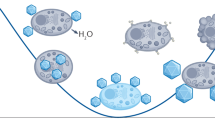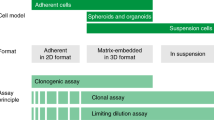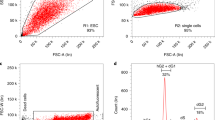Abstract
This protocol describes the principles and methods used for the preparation of cryopreserved cell stocks. Following these procedures will ensure the availability of reproducible cultures for use within a single laboratory at different times and for different collaborating laboratories. Although the basic principle is simple, each cell line has characteristics that must to be borne in mind when establishing and testing such stocks. The key requirements are reliable methods for culture, cryopreservation, characterization and quality control.
This is a preview of subscription content, access via your institution
Access options
Subscribe to this journal
Receive 12 print issues and online access
$259.00 per year
only $21.58 per issue
Buy this article
- Purchase on Springer Link
- Instant access to full article PDF
Prices may be subject to local taxes which are calculated during checkout

Similar content being viewed by others
References
Budapest Treaty Regulations (1977). Budapest Treaty on the International Recognition of the Deposit of Microorganisms for the Purposes of Patent Procedure, 277 (E) (World Intellectual Property Organisation, Geneva, 1981).
Day, J.G. & Stacey, G.N. (eds.) Cryopreservation and Freeze-Drying Protocols 2nd edn. (Humana Press, Totowa, New Jersey, 2007).
Tedder, R.S. et al. Hepatitis B transmission from a contaminated cryopreservation tank. Lancet 346, 137–140 (1995).
Masters, J.R.W. et al. Short tandem repeat profiling provides international reference standards for human cell lines. PNAS (USA) 98, 8012–8017 (2001).
MacLeod, R.A.F. et al. Widespread intra-species cross-contamination of human tumour cell lines arising at source. Int. J. Cancer 83, 555–563 (1999).
Stacey, G. et al. Cell contamination leads to inaccurate data: we must take action now. Nature 403, 356 (2000).
Wang, H. et al. Comparative analysis and integrative classification of NC160 cell lines and primary tumors using gene expression profiling data. BMC Genomics 7, 166 (2006).
Coecke, S. et al. Guidance on good cell culture practice. ATLA 33, 261–287 (2005).
European Pharmacopeia. European Pharmacopeia section 2.6.1 (Sterility) 5th edn. (Maisonneuve SA, Sainte Ruffine, France, 2006).
European Pharmacopeia. European Pharmacopeia section 2.6.7 (Mycoplasma) 5th edn. (Maisonneuve SA, Sainte Ruffine, France, 2006).
US Food and Drugs Administration. Title 21, Code of Federal Regulations, Volume 7, revised April 2005, CFR610.12 (Sterility) (FDA, Department of Health and Human Services, 2005).
US Food and Drugs Administration. Title 21, Code of Federal Regulations, Volume 7, revised April 2005, CFR610.30 (Test for Mycoplama) (FDA, Department of Health and Human Services, 2005).
Masters, J.R. & Stacey, G.N. Changing medium and passaging cell lines. Nat. Protoc. 2, 2276–2284 (2007).
Morris, C.B.M Chapter 1.6 Routine Subculturing. In Cell and Tissue Culture for Medical Research (eds. A. Doyle & J.B. Griffiths) 38–44 (John Wiley & Sons Ltd, Chichester, 2000).
Freshney, R.I. Culture of Animal Cells 4th edn. (Wiley Liss, New York, 2000).
Author information
Authors and Affiliations
Corresponding author
Rights and permissions
About this article
Cite this article
Stacey, G., Masters, J. Cryopreservation and banking of mammalian cell lines. Nat Protoc 3, 1981–1989 (2008). https://doi.org/10.1038/nprot.2008.190
Published:
Issue Date:
DOI: https://doi.org/10.1038/nprot.2008.190
This article is cited by
-
Generation of quality-controlled SARS-CoV-2 variant stocks
Nature Protocols (2023)
-
Cryopreservation of Iranian Markhoz goat fibroblast cells as an endangered national genetic resource
Molecular Biology Reports (2021)
-
Biological impact of xeno-free chemically defined cryopreservation medium on amniotic epithelial cells
Stem Cell Research & Therapy (2016)
-
Digital PCR to assess gene-editing frequencies (GEF-dPCR) mediated by designer nucleases
Nature Protocols (2016)
-
A high-yield double-purification proteomics strategy for the identification of SUMO sites
Nature Protocols (2016)
Comments
By submitting a comment you agree to abide by our Terms and Community Guidelines. If you find something abusive or that does not comply with our terms or guidelines please flag it as inappropriate.



